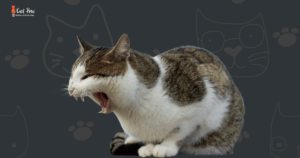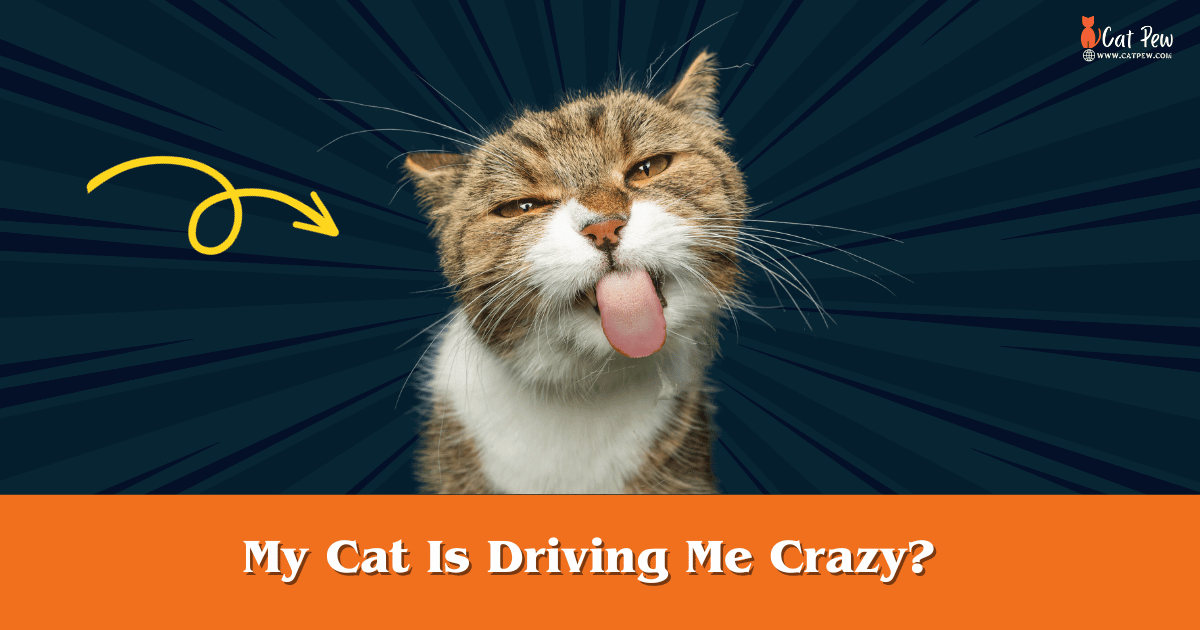My Cat Is Driving Me Crazy?
My cat’s behavior is driving me crazy, but there are ways to address and improve it. Living with a cat can be a joyous experience, filled with cuddles and playful antics.
However, sometimes, our feline friends can exhibit behaviors that leave us feeling frustrated and exasperated. From incessant meowing to relentless scratching on furniture, these habits can drive even the most patient cat owner up the wall. But don’t worry. Some solutions and techniques can help address and improve your cat’s behavior.
Discover solutions for common cat behavior problems with our comprehensive guide on ‘My Cat Is Driving Me Crazy.’ Learn effective tips and advice to address these issues, restoring calm and harmony in your home. Embrace a fulfilling relationship with your feline companion by implementing proven strategies. Let’s embark on the journey to a more peaceful coexistence with your cat!
Understanding Your Cat’s Behavior

Discover the nuances behind your cat’s seemingly erratic actions and uncover the underlying reasons for behaviors that might be driving you crazy. From playfulness to peculiar quirks, gaining insights into your cat’s psychology can transform your relationship. Explore the comprehensive guide to deciphering feline behavior, offering practical advice and proven techniques to channel your cat’s energy positively.
Why Do Cats Act Out?
Cats are fascinating creatures, full of unique behaviors and quirks that can sometimes leave us scratching our heads. You’re not alone if you wonder why your cat is acting out. Understanding the reasons behind your cat’s behavior is crucial in effectively addressing and managing their habits.
One of the primary reasons behind your cat’s acting out could be boredom. Despite their independent nature, cats need mental stimulation to keep them content. Without enough engagement and entertainment, they might resort to attention-seeking behaviors like scratching furniture, excessive meowing, or aggression. Providing your feline friend with plenty of interactive toys, scratching posts, and regular playtime can alleviate their boredom and help redirect their energy in more appropriate ways.
The Role Of Boredom In Cat Behavior
Boredom can significantly impact a cat’s behavior and overall well-being. Imagine spending long hours alone with nothing stimulating to do – it would quickly become frustrating, right? Cats require mental stimulation to prevent boredom-induced misbehavior.
When a cat is bored, they may engage in destructive activities like scratching furniture, knocking things off shelves, or getting into places they shouldn’t. It’s their way of seeking attention and relieving their pent-up energy. To combat boredom, offer a range of toys that encourage play and interaction. Rotate toys frequently to keep their interest piqued, and consider utilizing puzzle feeders and treat-dispensing toys to engage their problem-solving skills.
Recognizing Common Signs Of Stress In Cats
Cats are empathetic creatures and can quickly become stressed. Recognizing common signs of stress is crucial for maintaining their overall well-being. By understanding the telltale indicators, you can promptly alleviate their stress before it escalates.
Every cat is different, but common signs of stress include excessive grooming, changes in appetite, hiding or seeking seclusion, excessive vocalization, aggression, and litter box avoidance. These behaviors often respond to a change or disruption in their environment, such as moving to a new home, introducing a new pet, or loud noises. Creating a safe and stable environment, offering plenty of hideaways, and providing a consistent routine can help reduce stress levels for your feline companion.
Creating A Stimulating Environment

Living with a cat can be a joyful experience, but sometimes, our furry friends can drive us crazy with their endless energy. One way to combat this is by creating a stimulating environment for your cat. By providing the right kind of toys, games, and spaces, you can keep your cat engaged and entertained, helping alleviate some excess energy. Here are a few tips on creating a stimulating environment to keep your cat happy and your sanity intact.
Designing A Cat-friendly Living Space
Designing a cat-friendly living space is essential to creating a stimulating environment for your feline companion. Cats are naturally curious creatures who thrive in an environment that allows them to explore and climb. Consider setting up various levels in your home, such as shelves or cat trees, where your cat can perch and observe their surroundings. This provides them with a sense of security and encourages exercise and mental stimulation.
Providing Interactive Toys And Games
Interactive toys and games are another great way to keep your cat entertained and mentally stimulated. Look for toys that simulate hunting, such as interactive puzzle toys or feather wands that mimic the movement of prey. These toys encourage your cat to use their instincts and keep them engaged for hours. Additionally, rotating their toys regularly will prevent boredom and keep their interest piqued. Try to find toys that are safe, durable, and specifically designed for cats.
Introducing Vertical Space For Climbing And Exploring
Cats love to climb and explore their surroundings, so providing them with vertical space is crucial. Consider installing cat shelves or strategically placing tall furniture that your cat can climb and perch on. This satisfies their natural instinct to climb and explore high places and provides them with a territory to call their own. Vertical space also helps save your furniture from sharp claws, as cats instinctively reach for vertical surfaces when scratching.
Benefits of a Stimulating Environment for Your Cat: |
|---|
| – Promotes exercise and mental stimulation |
| – Reduces destructive behaviors |
| – Encourages natural instincts |
| – Provides a sense of security and territory |
In conclusion, creating a stimulating environment for your cat is essential for their well-being and your peace of mind. By designing a cat-friendly living space, providing interactive toys and games, and introducing vertical spaces for climbing and exploring, you can combat destructive behaviors, keep your cat mentally and physically fit, and enjoy a harmonious coexistence with your feline friend.
Establishing A Routine And Boundaries

A naughty and hyperactive cat can bring endless joy to your home but can also leave you feeling overwhelmed and frustrated. One effective way to regain control and restore harmony is by establishing a routine and boundaries for your feline friend. By setting a consistent feeding schedule, creating a designated playtime, and teaching basic commands and limitations, you can help your cat feel more secure and content while ensuring your sanity remains intact.
Setting A Consistent Feeding Schedule
Like humans, cats thrive on routines, and setting meal times can bring structure to their day. By establishing a consistent feeding schedule, you not only promote good eating habits for your furry buddy but also help regulate their energy levels. Whether your cat prefers wet or dry food, stick to the exact feeding times daily. This not only helps avoid overeating but also prevents your cat from becoming overly demanding or constantly meowing for food. Remember, a well-fed cat is a happy cat!
Creating A Designated Playtime
All cats, regardless of age, need regular playtime to release excess energy and indulge their natural hunting instincts. By designating a specific time each day for play, you can channel your cat’s boundless energy into positive and controlled activities. Interactive toys, such as feathers on a stick or laser pointers, can be especially engaging for cats. Rotate these toys regularly to keep things interesting and prevent boredom. Through play, you’ll tire out your cat physically and create a strong bond between the two of you.
Teaching Basic Commands And Boundaries
Like dogs, cats can be trained to follow basic commands and respect boundaries. This helps eliminate destructive behaviors and reinforces the idea of you as the pack leader. Start with simple commands like “sit” or “stay,” and reward your cat with treats or affection when they obey. For boundary training, use positive reinforcement to teach your cat where they are allowed to perch, sleep, or play. Consistency is key, so be patient and persistent in your training efforts. Soon enough, your cat will understand and respect your established rules.
Establishing a routine and boundaries allows you to regain control over your cat’s behavior and create a harmonious home environment. Remember to always use positive reinforcement and be patient with your furry friend. With time and consistency, you’ll experience the joy of having a well-behaved and contented cat.
Stress Reduction Techniques

Living with a cat can bring immense joy and companionship, but it can also come with its fair share of stress. Whether it’s constant meowing, destructive behavior, or accidents outside the litter box, there may be times when your cat’s behavior drives you crazy. However, instead of pulling your hair out in frustration, try these effective stress reduction techniques to create a calming environment for you and your beloved feline companion.
Using Pheromone Diffusers To Create A Calming Environment
One effective way to reduce stress in cats is using pheromone diffusers. These diffusers release synthetic pheromones that mimic the natural ones produced by cats, creating a sense of familiarity and security. This can help to soothe cats in stressful situations, such as when introducing a new pet or during loud noises like thunderstorms or fireworks. Simply plug in the diffuser in the area where your cat spends most of its time and let the calming effects take hold. This easy-to-implement solution can make a world of difference by creating a harmonious home atmosphere.
Implementing A Daily Relaxation Routine
Just like humans, cats thrive on routine. A daily relaxation routine can give your cat a sense of structure and calmness. Start by setting aside a specific time for dedicated relaxation sessions with your cat each day. Create a cozy space with soft bedding, toys, and soothing music. A safe and comfortable environment will help your cat unwind and alleviate pent-up stress or anxiety. Spending quality time with your cat during these relaxation sessions can also strengthen your bond and promote your overall well-being.
Exploring Alternative Therapies Like Music Or Aromatherapy
In addition to pheromone diffusers and relaxation routines, exploring alternative therapies like music or aromatherapy can also reduce stress for your cat. Research has shown that certain types of music, such as classical tunes or specially designed cat relaxation music, can have a calming effect on cats. Similarly, introducing gentle scents through aromatherapy can create a serene atmosphere. Lavender and chamomile are known for their calming properties and can be diffused in the room or applied to a bandana that your cat wears. It’s important to monitor your cat’s response to these therapies and adjust accordingly to ensure their comfort and well-being.
Incorporating these stress reduction techniques into your daily life can create a more peaceful environment for you and your cat. Experiment with different methods to find what works best for your feline friend, and remember to remain patient and understanding throughout the process. A calm and content cat will reduce stress for everyone involved and lead to a happier and healthier home.
Addressing Common Cat Behavior Issues

Cats are beloved companions, but sometimes, their behavior can drive us up the wall. From excessive scratching and furniture damage to nighttime disturbances and excessive meowing, as well as aggressive behavior towards humans or other pets, these issues can be frustrating for cat owners. But fear not, as there are practical steps you can take to address these common cat behavior issues.
Dealing With Excessive Scratching And Furniture Damage
Excessive scratching and furniture damage can be a real headache. Not only does it spoil the aesthetics of your home, but it can also be quite costly to repair or replace damaged items.
To tackle this issue effectively, consider implementing the following tactics:
- Provide your cat with appropriate scratching posts and boards. Cats have an instinct to scratch, so you can redirect their attention away from your furniture by giving them an acceptable outlet for this behavior.
- Apply double-sided tape or aluminum foil to the areas of furniture that your cat tends to scratch. The unfamiliar texture will discourage them from engaging in this destructive behavior.
- Regularly trim your cat’s nails or use nail caps to minimize the damage caused by scratching.
Coping With Nighttime Disturbances And Excessive Meowing
Sleepless nights and constant meowing can leave cat owners feeling exhausted and overwhelmed. Fortunately, there are strategies you can employ to address these nighttime disturbances effectively.
- Establish a consistent bedtime routine for your cat. This can include playtime before bed to expend their energy and a calming environment to encourage relaxation.
- Keep your cat’s sleeping area comfortable and cozy. Provide a warm bed with soft bedding to make them feel secure and relaxed.
- Avoid reinforcing nighttime behaviors by ignoring attention-seeking meowing. Instead, reward quiet behavior and provide positive reinforcement.
Managing Aggressive Behavior Towards Humans Or Other Pets
Aggressive behavior from your cat towards humans or other pets can be distressing and potentially dangerous. It’s essential to address this issue promptly to ensure the safety and well-being of everyone involved.
- Consult with a veterinarian to rule out any underlying medical conditions that may be causing aggression.
- Implement a consistent training program to teach your cat appropriate behavior and reinforce positive interactions.
- Provide separate spaces and resources for each pet, reducing the likelihood of territorial disputes.
- Avoid punishing aggressive behavior, as this can escalate the issue. Instead, focus on redirection and positive reinforcement to encourage more desirable behavior.
By following these guidelines, you can effectively address common cat behavior issues. Remember, patience and consistency are key when modifying your cat’s behavior. With time and effort, you can create a harmonious environment that promotes both your cat’s well-being and your own peace of mind.
Frequently Asked Questions Of My Cat Is Driving Me Crazy
How Do I Get My Cat To Shut Up At Night?
To prevent your cat from making noise at night, try these tips: 1. Establish a consistent sleep routine for your cat. 2. Provide plenty of physical and mental stimulation during the day. 3. Ensure your cat has a comfortable sleep area with toys and blankets. 4. Consider using a white noise machine or soft music to drown out noise. 5. Consult with a veterinarian to rule out any underlying health issues.
How Do I Stop My Cat From Being Crazy?
To stop your crazy cat, give them plenty of exercise with toys and playtime. Provide a scratching post to redirect their energy. Use positive reinforcement, rewarding calm behavior. Establish a routine for feeding and play to minimize stress. Consult a veterinarian if the behavior persists.
How Do You Deal With Cat Crazies?
To deal with cat crazies, engage your cat in playtime with interactive toys. Provide a scratching post or cat tree to redirect their energy. Create a routine for feeding and play sessions, ensuring daily exercise. Use positive reinforcement to reward good behavior. Seek veterinary advice if the behavior persists.
Why do cats have night crazies?
Cats are naturally nocturnal animals, and their increased activity at night is attributed to their hunting instincts and energy bursts.
How can I stop my cat from having night crazies?
Provide your cat with ample playtime and mental stimulation during the day to reduce nighttime restlessness.
How Do I Get My Cat To Stop Meowing All The Time?
To stop your cat from meowing all the time, try these tips: 1. Ensure your cat’s needs are met (food, water, litter box). 2. Spend quality time playing and interacting with your cat. 3. Avoid reinforcing meowing by ignoring it or providing attention when quiet. 4. Maintain a consistent routine for feeding and playtime. 5. Consult with a veterinarian if excessive meowing persists.
Conclusion
Dealing with an unruly cat can be frustrating, but there are ways to regain your sanity. By understanding your cat’s behavior, setting boundaries, and providing mental and physical stimulation, you can create a harmonious environment that reduces stress and prevents destructive behavior.
With patience and consistency, you can establish a happy and balanced relationship with your feline friend, ensuring peace and tranquility for both of you. Remember, a little effort goes a long way in taming the wild side of your cat!

Winston
I'm Winston, the author of this feline-focused (Catpew.com) blog . My love for cats goes back to my childhood, when I spent countless hours playing with my family's tabby, Mittens. This furry friend instilled in me a deep appreciation for the unique personalities, playful nature, and unconditional love that cats offer.

